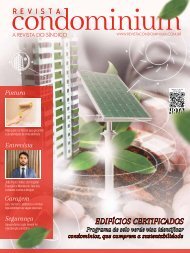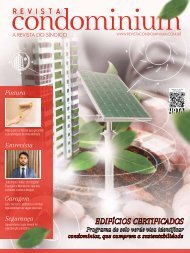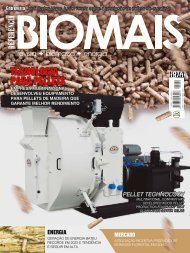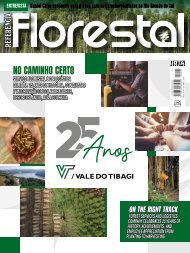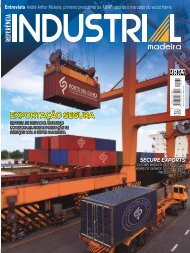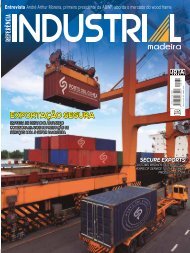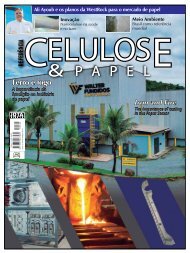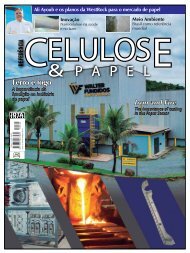Create successful ePaper yourself
Turn your PDF publications into a flip-book with our unique Google optimized e-Paper software.
ENTREVISTA<br />
>> Nos últimos anos, a madeira de acácia tem chamado a<br />
atenção do setor de reflorestamento no Brasil. A que se deve<br />
o crescimento deste interesse?<br />
O grande diferencial da acacicultura é a existência de duas<br />
linhas de produtos, uma vinda da madeira com suas propriedades<br />
e outra vinda da casca, com seu alto teor de tanino. Isso dá<br />
uma vantagem importante pela atuação em mercados diversificados.<br />
Após 2009 ocorreram dificuldades econômicas a nível<br />
mundial que impactaram os mercados em geral. Passadas essas<br />
condições extraordinárias estamos investindo no desenvolvimento<br />
de novos produtos para aproveitamento da casca e da<br />
madeira, retomando nossa base florestal, fomentando terceiros<br />
e tendo maior necessidade na compra de matéria-prima. Com<br />
maior demanda valoriza-se a cultura, com maiores oportunidades<br />
para os acacicultores, indústria e toda a cadeia produtiva.<br />
>> Por que a acácia ainda não tem uma representatividade<br />
maior no setor florestal?<br />
A acácia é uma árvore de menor volume em comparação com<br />
as florestas de pinus e eucaliptos no Brasil. Essa diferença diminui<br />
a partir dos nossos trabalhos em melhoramento genético,<br />
mas vai continuar existindo. Já no Rio Grande do Sul onde ocorre<br />
a industrialização da casca a espécie tem boa representatividade,<br />
sobretudo pelo incentivo do plantio junto a produtores<br />
independentes. É histórica e largamente conhecida a grande<br />
distribuição da espécie por pequenas e médias propriedades.<br />
>> Existe algum cuidado especial no plantio da acácia?<br />
Em geral os mesmos de outras florestas: seleção de mudas,<br />
controle de formigas e de mato competição, etc. A carga geral<br />
de adubos é menor, em parte pelo próprio crescimento, mas<br />
principalmente porque o nitrogênio, fortemente demandado<br />
por todas as culturas é desnecessário no caso desta leguminosa,<br />
que deixa um saldo positivo em torno de 200 Kg/ha/ano ao<br />
longo da rotação. Nos plantios de acácia há necessariamente<br />
um cuidado especial com o controle do cascudo serrador, inseto<br />
que corta galhos e ponteiras, prejudicando forma e crescimento.<br />
Infelizmente ainda não existem produtos com registro<br />
para a espécie limitando o controle à queima dos galhos infestados,<br />
com suas próprias dificuldades.<br />
>> Em seu artigo: Acácia: um gerador de riqueza; diz que as<br />
características silviculturais da acácia negra a tornaram a espécie<br />
preferida de muitas propriedades de pequeno e médio<br />
porte. É isso mesmo?<br />
A introdução da espécie, no início do século passado foi feita<br />
em função da casca na região mais industrializada do Estado.<br />
As propriedades rurais da região já eram em geral pequenas e<br />
a demanda pela madeira, de boa densidade e alto poder calorífico,<br />
foi sempre alta e diversificada. A facilidade na renovação<br />
dos plantios associados a culturas agrícolas de subsistência<br />
manteve a espécie sempre presente. Outro fator importante<br />
foi a transformação em carvão vegetal também distribuída nas<br />
inúmeras propriedades. A produção de carvão tem destaque<br />
regional e compete fortemente com outros usos industriais da<br />
madeira.<br />
In recent years, acacia has drawn the attention of the Planted<br />
Forest Sector in Brazil. Why has there been a growth in<br />
the interest of this species?<br />
The significant differential of acacia is two product lines, one<br />
from the wood itself, with its unique properties, and another<br />
from the bark, with its high tannin content. Thus, acacia has<br />
an essential advantage by acting in two completely different<br />
markets. After 2009, there were global economic difficulties<br />
that impacted markets in general. Under these extraordinary<br />
conditions, we began investing in developing new products<br />
to make use of the bark and the wood, resuming our forest<br />
base, fostering third-party use, and having a greater need to<br />
purchase raw materials. With the greater demand, the culture<br />
became more valued, with significantly more opportunities for<br />
the acacia growers, industry, and the entire production chain.<br />
Why does acacia still not have a better representation in the<br />
Forest Sector?<br />
Acacia is a lower volume tree compared to pine and eucalyptus<br />
in Brazil. This difference is being reduced due to our<br />
work on genetic improvement but will continue to exist. In<br />
the State of Rio Grande do Sul, where the industrialization of<br />
the bark occurs, the species is well represented, mainly due to<br />
encouraging planting by independent producers. Historically,<br />
it is widely known for the extensive distribution of the species<br />
among small and medium-sized properties.<br />
Is there any special care needed in planting acacia?<br />
In general, the same as for other forest types: the selection of<br />
seedlings, ant control, underbrush competition, etc. Overall<br />
fertilization is less, partly due to its growth, but mainly<br />
because nitrogen, very much needed by most cultures, is<br />
unnecessary for growing acacia, which has a positive balance<br />
of around 200 kg/ha/year throughout its rotation cycle. For<br />
acacia plantations, there is a necessity for special care for<br />
the control of the longhorn beetle, an insect that cuts into<br />
the branches and eats the tips, impairing shape and growth.<br />
Unfortunately, there are still no products registered for the<br />
control of this pest, limiting control to the burning of infested<br />
branches, with the difficulties of doing so.<br />
In your article ‘Acacia: a wealth generator,’ you say that the<br />
forestry characteristics of black acacia have made it the preferred<br />
species of many small and medium-sized properties.<br />
Why is that?<br />
At the beginning of the last century, the species was introduced<br />
in the most industrialized region of the State in the<br />
function of the bark. The rural properties in the area were already<br />
generally small, and the demand for wood with a good<br />
density and high calorific value was always large and diversified.<br />
The ease in renewing plantations associated with other<br />
agricultural activities led to the species always being present.<br />
Another critical factor the transformation into charcoal, also<br />
distributed among numerous properties. Charcoal production<br />
has a regional prominence and competes strongly with other<br />
industrial uses of the wood.<br />
32 www.referenciaflorestal.com.br



